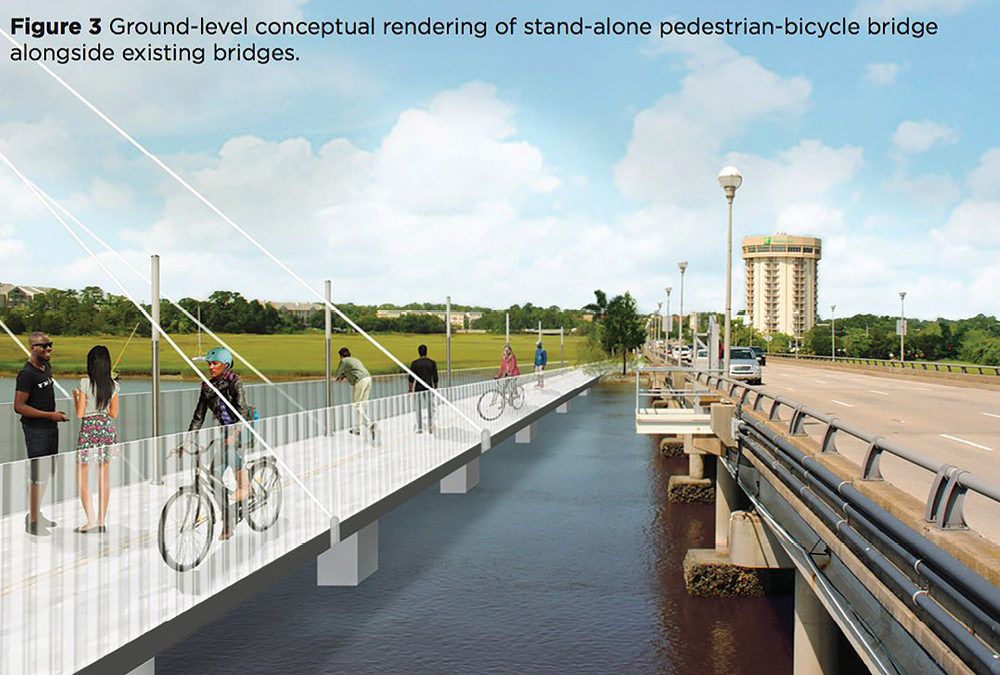Money for bike/walking bridge over Ashley River flows
by Bill Davis | News Editor
Looks like West Ashleyians will finally get a way to ride a bike or walk to the peninsula, just like Mt. Pleasanter have over the Ravenel Bridge.
Last month, as it was first reported by the office of U.S. Sen. Lindsey Graham (R-S.C.), the federal Department of Transportation relented and approved the third application for a bicycle/pedestrian bridge over the Ashley River to be built alongside the current car bridges.
Last year, there was a pilot effort to shut down a single lane of Highway 17 going in from West Ashley onto the peninsula. But that was quickly scrapped after a hail of public criticism and a bunch of political resistance, as morning car traffic was deemed sacrosanct.
Enter County Councilman Brantley Moody. Moody was a vocal and strident opponent to dedicating a lane of traffic to bike and walking, as many of his constituents would be rolling down it to their jobs downtown in cars.
Moody offered to find matching county funds from the current half-cent sales tax revenues to help the effort for a stand-alone bridge. He culled enough political will on County Council that $3 million was offered.
That would leave close to another $20 million to fund an elevated pathway for bikers and walkers that would also raise and lower for boat traffic just like the existing two “car” bridges.
Charleston Moves, a local advocacy group supporting non-car transportation options led by Katie Zimmerman went about lining up local private matching donations should the federal government approve the city’s request for funding.
Apparently, the third time was the charm, as the feds have now ponied up $18 million, and with the exception of planning, designing, engineering, environmental clearing, architecture, naming, and deciding who is on the hook for building the project and swallowing any (expected) cost overruns, the bridge is practically completed.
Ahem.
Zimmerman cautions, understandably, that while there is cause for celebration, patience will be at a premium. She points out how long the completion of the 526-completion project has taken and is taking.
She praises the “bipartisan” effort from the federal delegation representing the Lowcountry in Washington, D.C. for how far it’s come so far.
Zimmerman says there are pros and cons to which ever governmental entity takes authorship of the project, with the city and the state DOT being the most likely candidates. One is quicker, the other more experienced.
She says her advocacy group will continue to be engaged in the fund-raising process to help with cost overruns or needs for additional capital. As such, MUSC has just committed several hundred thousand dollars toward the local private match that, she says acknowledging the cheap pun, “helped bridge the gap.”
The bicycle/walking bridge will help continue the national bike/walk trail that is close to completely connecting the entire eastern seaboard of the country. Charleston is one of the biggest, most crucial missing links in that effort.
Keith Benjamin, the director of the city’s Traffic and Transportation office, says the most important aspect of the project is making sure that Charleston is no longer “number one in the state in bike and pedestrian fatalities. We’re not proud of that, and something has to be done to address that and it’s something we simply can’t ignore.”
Benjamin likes the safety provided by separating bicyclists and walkers from car traffic, but like Zimmerman, cautions that the sense of urgency this project has engendered needs to be met with sound execution.
Benjamin says that the first phase of the project – improving intersections and connectivity along West Ashley’s greenway and bikeway – can be started before construction of the actual bridge would begin.
He says the bridge could act as a “trigger point” in the fight to introduce more multimodalism to the area’s traffic patterns, giving commuters more options that just sitting in traffic in their car.
Benjamin foresees a day when a paved Bikeway feeds into a paved Greenway across enhanced and safe intersections along their paths, and then feed bikers and walkers into an area just next to the relatively new 35 Folly apartment complex, linking West Ashley with improvements already made along Lockwood Drive down to the Battery.
While that will take a lot of work, he praises all the “behind the scenes” work that went on with the local federal delegation to get the money flowing and the project approved. That being said, Benjamin says it was “pretty cool” to talk about the approval with locals who first brought up the idea back in the ‘70s and ‘80s.
Harry Lesesne, the executive director of the Charleston Parks Conservancy, has already led the effort to improve the Greenway and Bikeway. He calls the bridge project a “game changer” that could enhance the value of all greenspace in the area.
“I think it enhances downtown, too,” not just West Ashley, says Lesesne. “It makes it easier to get around the entire community better, and I think it makes all of Charleston more valuable – not from a property value sense, but from it being a better place to live.”
“This is a great thing, and if there are people who don’t like public spaces, then that’s their problem … not much can be done for those people,” he says.








